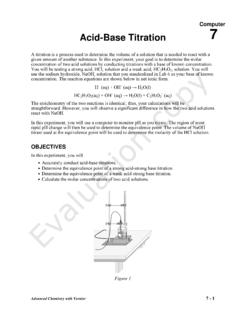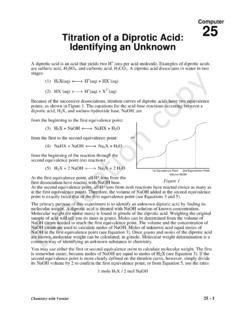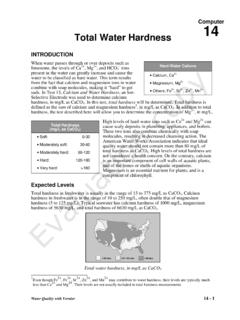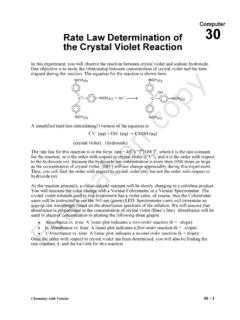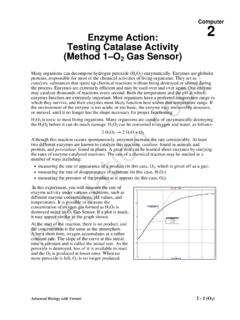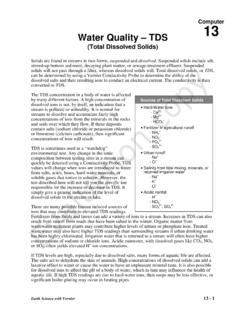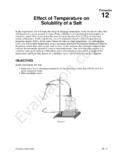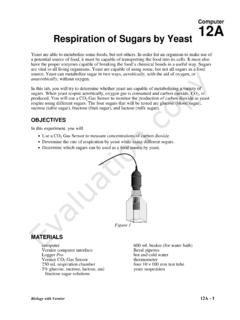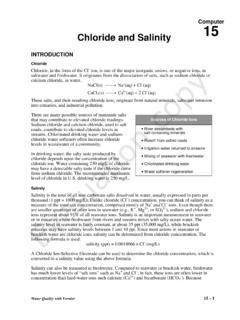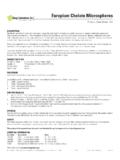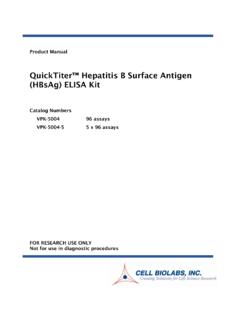Transcription of The Effect of Alcohol on Biological Membranes
1 Computer 8 Biology with Vernier 8 - 1 The Effect of Alcohol on Biological Membranes The primary objective of this experiment is to determine the stress that various alcohols have on Biological Membranes . Membranes within cells are composed mainly of lipids and proteins and often serve to help maintain order within a cell by containing cellular materials.
2 Different Membranes have a variety of specific functions. One type of membrane -bound vacuole found in plant cells, the tonoplast, is quite large and usually contains water. In beet plants, this membrane -bound vacuole also contains a water-soluble red pigment, betacyanin, that gives the beet its characteristic color. Since the pigment is water soluble and not lipid soluble, it remains in the vacuole when the cells are healthy. If the integrity of a membrane is disrupted, however, the contents of the vacuole will spill out into the surrounding environment. This usually means the cell is dead. In this experiment, you will test the Effect of three different alcohols (methanol, ethanol, and 1-propanol) on Membranes .
3 Ethanol is found in alcoholic beverages. Methanol, sometimes referred to as wood Alcohol , can cause blindness and death. Propanol is fatal if consumed. One possible reason why they are so dangerous to living organisms is that they might damage cellular Membranes . Methanol, ethanol, and 1-propanol are very similar alcohols , differing by the number of carbon and hydrogen atoms within the molecule. Methanol, CH3OH, is the smallest, ethanol, CH3CH2OH, is intermediate in size, and 1-propanol, CH3CH2CH2OH, is the largest of the three molecules. If beet Membranes are damaged, the red pigment will leak out into the surrounding environment.
4 The intensity of color in the environment should be proportional to the amount of cellular damage sustained by the beet. To measure the color intensity, you will be using a Colorimeter or Spectrometer. In this device, blue light from the LED light source will pass through the solution and strike a photocell. The Alcohol solutions used in this experiment are clear. If the beet pigment leaks into the solution, it will color the solution red. A higher concentration of colored solution absorbs more light and transmits less light than a solution of lower concentration. The device monitors the light received by the photocell as either an absorbance or a percent transmittance value.
5 You are to prepare five solutions of differing Alcohol concentrations (0%, 10%, 20%, 30%, and 40%) for each of the three alcohols . A small piece of beet is placed in each solution. After ten minutes, each Alcohol solution is transferred to a cuvette that is placed into the Colorimeter or Spectrometer. The amount of light that penetrates the solution and strikes the photocell is used to compute the absorbance of each solution. The absorbance is directly related to the amount of red pigment in the solution. By plotting the percent Alcohol vs. the amount of pigment (that is, the absorbance), you can assess the amount of damage various alcohols cause to cell Membranes .
6 OBJECTIVES In this experiment, you will Use a Colorimeter or Spectrometer to measure the color intensity of beet pigment in Alcohol solutions. Test the Effect of three different alcohols on Membranes . Test the Effect of different Alcohol concentrations on Membranes . Evaluation copyComputer 8 8 - 2 Biology with Vernier MATERIALS computer cotton swabsVernier computer interface* forcepsLogger Pro knifeColorimeter or Spectrometer lab apronfour graduated Beral pipets microplate, 24-well 10 mL 1-propanol one pair gloves10 mL ethanol ruler (cm)
7 10 mL methanol tap waterthree 18 150 mm test tubes with racktimer or stopwatch100 mL beaker tissues (preferably lint-free) beet root toothpick * Not necessary if using a Spectrometer. PROCEDURE 1. Obtain and wear goggles, an apron, and gloves. CAUTION: The compounds used in this experiment are flammable and poisonous. Avoid inhaling vapors. Avoid contacting them with your skin or clothing. Be sure there are no open flames in the lab during this experiment. Notify your teacher immediately if an accident occurs.
8 2. Obtain the following materials: a. Place about 10 mL of methanol in a medium sized test tube. Label this tube M. b. Place about 10 mL of ethanol in a medium sized test tube. Label this tube E. c. Place about 10 mL of 1-propanol in a medium sized test tube. Label this tube P. d. Place about 30 mL of tap water in a small beaker. 3. Prepare five methanol solutions (0%, 10%, 20%, 30% and 40%). Using Beral pipets, add the number of drops of water specified in Table 1 to each of five wells. Use a different Beral pipet to add Alcohol to each of five wells in the microwell plate. See Table 1 to determine the number of drops of Alcohol to add to each well.
9 Table 1 Well H2O Alcohol Concentration number drops drops of Alcohol (%) 1 64 0 0 2 57 7 10 3 51 13 20 4 44 20 30 5 38 26 40 The Effect of Alcohol on Biological Membranes Biology with Vernier 8 - 3 4.
10 Clean the pipet used to transfer Alcohol . To do this, wipe the outside clean and empty it of liquid. Draw up a little ethanol into the pipette and use the liquid to rinse the inside of the pipette. Discard the ethanol. 5. Prepare five ethanol solutions. To do so, repeat Step 3, substituting ethanol for methanol. Place each solution in the second row of wells. See Figure 1. 6. Prepare five 1-propanol solutions. To do so, clean your pipette and repeat Step 3, substituting 1-propanol for methanol. Place each solution in the third row of wells. See Figure 1. 7. Now, obtain a piece of beet from your instructor.
